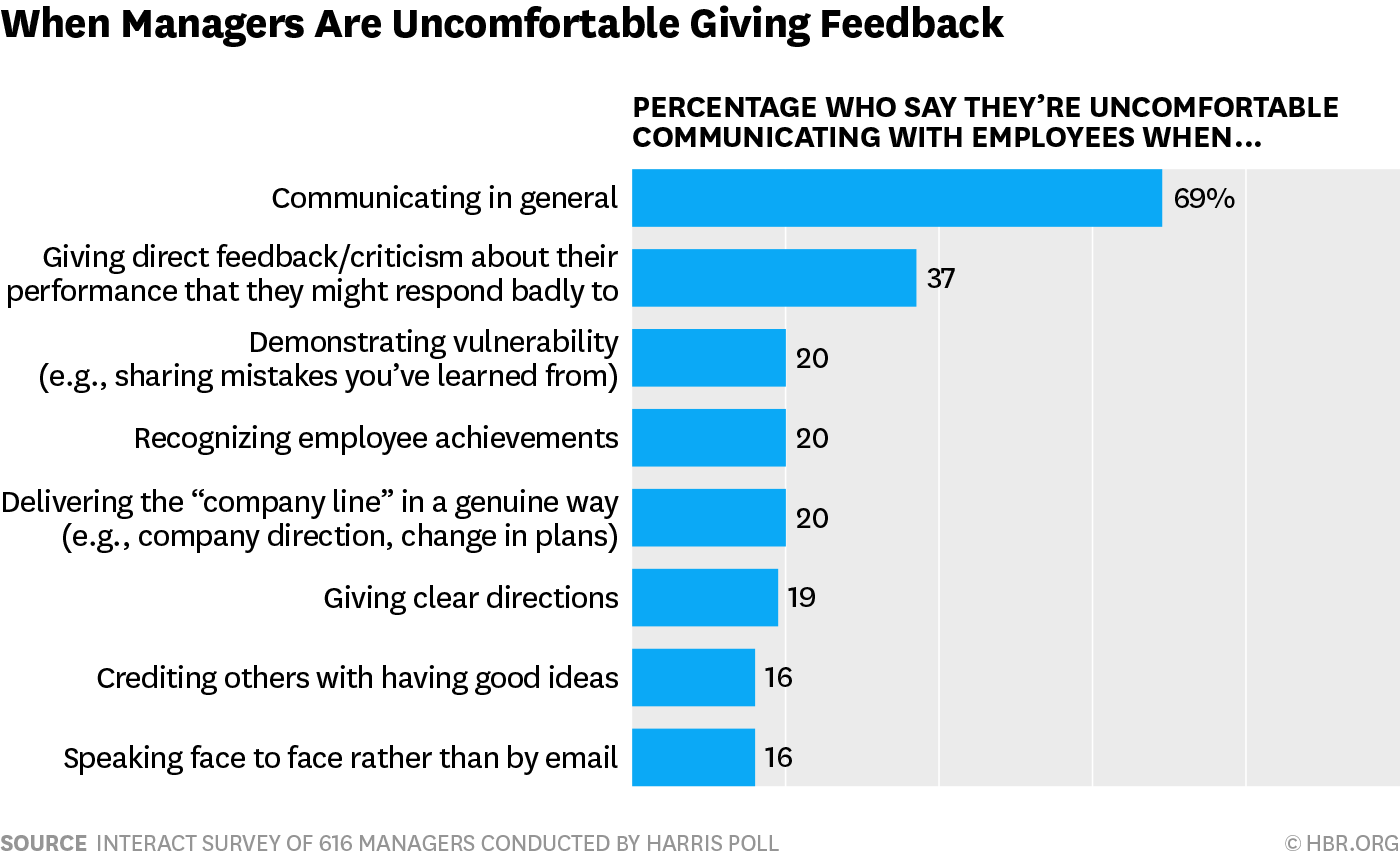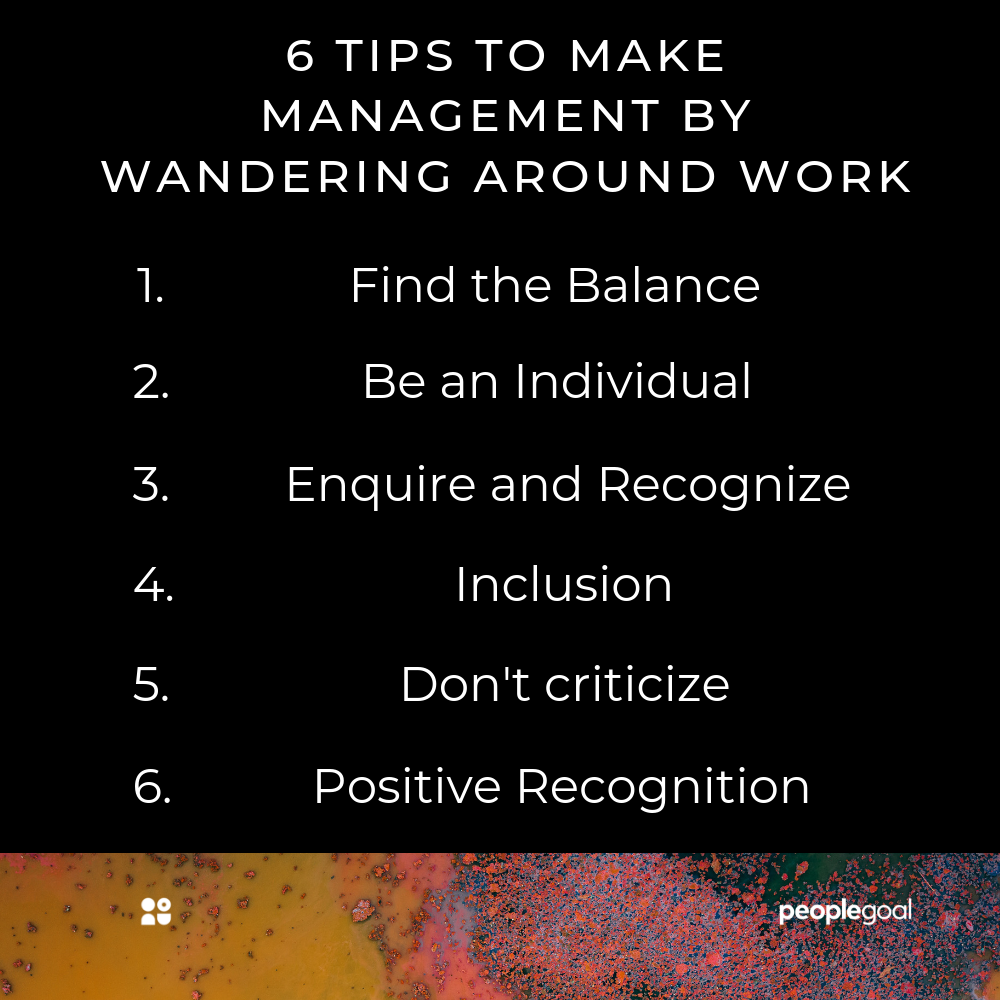- Leadership Styles Portal
- Leadership Styles Articles
- Charismatic Leadership
- Democratic Leadership
- Laissez-Faire Leadership
- Transactional Leadership
- Leadership Theories
- Leadership Advice
- Communication
- About the author
Learn about Resonant Leadership, Emotional Intelligence the six leadership styles and how to practically switch between the styles to become a more effective , flexible and impactful leader!

Management By Walking Around Explained By a CEO
Management by Walking Around is a very beneficial concept for leaders. I have used it to great effect during my CEO career, where it has contributed to driving employee engagement extraordinarily fast, as I will share with you in this article.
Management By Walking Around (MBWA) is a strategy where managers roam the workplace at random. Those applying the Management By Walking Around approach make unplanned visits to engage employees and learn about equipment, routines, customers, and other operational aspects.
Keep on reading to learn more about management by walking around, how to do it, advantages and disadvantages, and some personal experiences from when I have applied MBWA with great success in my job as a CEO, resulting in a significant difference in organizational culture .
LEADERSHIP ORIGINS A 116 page E-book with articles on Great Man Theory, Trait Theory, Behavioral Theories (Lewin, Ohio, Michigan, Blake & Mouton), Contingency Theories (Fiedler, Path-Goal, Situational)
Management By Walking Around Explained
The characteristics of management by walking around, pros and cons of management by walking around, how to implement and use management by walking around, a ceo’s example of management by walking around, examples of management by walking around leaders, further reading.
The concept of management by walking around emerged back in the early 80s, 1982 to be specific when Tom Peters and Robert Waterman introduced it in their book named “In Search of Excellence”. Peters and Waterman had followed successful leaders and concluded that they did not stay in their “ivory towers” but instead spent time out in the organization, walking around the area and interacting with employees.
Management by walking around, otherwise known as management by wandering around (MBWA), is a management style that involves strolling around the work area in a seemingly unstructured manner. Managers spontaneously stop for a conversation with employees, learning more about equipment, functions, and processes in the workplace. As a manager stops by for informal discussions, she also makes herself available for employees and any questions they might want to raise. This approach builds participation and is an example of the democratic leadership style and MBWA requires a lot of Emotional Intelligence on the leader’s part. (Read our free e-book on Emotional Intelligence .) The method of Management by walking around depends on each company’s layout and everyday routines; walking on a factory floor or in a department store is different, but in the end, it is meeting the team members that is the point.
What is the aim of Management By Walking Around?
Management by walking around intends to achieve higher productivity and efficiency through accurate representations of daily happenings and understanding the employees’ perspectives. The leader regularly feels “the pulse” of the organization, which provides crucial input for decision-making and communication.
Is management by walking around effective?
Management By Walking Around is incredibly effective in workplaces that involve teams, routines, tasks, production, and knowledge workers. The approach is far more effective than arranged visits, as managers gain truthful insight through dialogue and witnessing operations firsthand.
Are there any dangers in the use of Management By Walking Around?
Management By Walking Around effectiveness is subject to each unique manager. Some managers walk around with the wrong attitude, leading to disgruntled, uncomfortable, and pressured employees who feel micromanaged. This behavior will hurt performance rather than strengthening it.
Develop yourself with these products from Leadershipahoy.com
Intrapersonal Communication: Your Inner Dialogue
– Understand Your Thinking – Self-Coaching – Channel Your Thoughts – Improve Social Skills
Leadership Styles The Classics
– Learn the Lewin Styles: Autocratic, Democratic, Laissez-Faire Leadership – Understand the Experiments And Conclusions
Leadership Origins
A 116 page E-book with Leadership Theories Over The Years: From Great Man And Trait Theory To Situational Leadership Theories
Pacesetting Leadership: A CEO’s Blueprint
– Master Pacesetting!
– Get results without unnecessary team stress
– Learn How to Push Performance from a CEO
The Management By Walking Around (MBWA) approach to leadership involves the following elements and characteristics:
- Walking around the workplace
- Talking to employees
- Creating personal networks
Unstructured Visits
Engagement and discussion style, personal interactions with a supportive attitude.
The first three might seem rather self-evident, but there are still some important aspects to keep in mind. That is why we will go through each of the six elements in greater detail.
Walking Around the Workplace
By simply walking around, managers show presence, interest, and respect for the different parts of company operations. This stroll is an opportunity to “walk the talk” when it comes to wearing the proper personal protection equipment (PPE), following safety routines, walk the appropriate paths, and all the other rules and regulations others are expected to follow. Managers who do not follow their own rules stick out like sore thumbs. Furthermore, it is essential to cover the entire area, not staying in the warm inside offices while skipping the remote outdoors storage area in the wintertime and taking other comfortable shortcuts. After a while, people might emphasize where the manager isn’t going rather than the places that get the attention, resulting in a perceived bias, lack of interest, and respect felt by the ignored team members.
Talking to Employees
It sounds like an easy thing to “talk to employees”, but that can sometimes be far from the truth. As a manager, you need to ask the right questions, display the appropriate mood, and show the right level of interest. Make sure you lower the threshold for people to dare to engage in conversation with you. Use Emotional Intelligence to gauge the mood of people and start conversations in a non-threatening and informal manner. Ask open-ended questions and get them to do the talking. Tell people about yourself and your thoughts; otherwise, you can’t expect them to share anything with you, right? Note: This should NOT be questioning or interrogating them for status updates, which would be commanding or autocratic leadership .
Creating Personal Networks
Managers who use management by walking around get an abundance of opportunities to form bonds and relationships with people they usually would not engage with regularly. Remember items from your previous visit and bring them up; you can even make short notes if necessary. Notice and learn what people do, how they work with, etc. This can increase your effectiveness as a manager since you can find talented people, know who to ask, where to get support on specific tasks, etc. By showing people that you care enough to create bonds with them, even if they are light ones, you will earn people’s respect and loyalty, and they are more likely to go the extra mile for you. If you do management by walking around appropriately, that is. (This is a good example of Affiliative Leadership .)
The primary characteristic of management by walking around is the style and method of roaming, as it should be unplanned or spontaneous. Managers need to utilize random sampling of events, employee discussions, and unplanned stops.
Management by walking around is far more impactful than planned appointments, timely status reports, and formal review meetings, often becoming a bit of a dog and pony show. By making unplanned visits, managers can see what goes on in the workplace and assess areas needing adaptions or intervention. At the same time, employees benefit from being listened to and understood in a more realistic and empathetic manner.
Just don’t interrupt people when they are busy. After all, this should not be about you, it should be about the team members.
When managers make their unplanned stops at various employees’ workstations or areas of processes, the atmosphere created is key to the strategy’s effectiveness. The visits should feel unforceful and purposeless, even if the manager intends to stop by a specific area on that particular day. If you fail to do this, team members will simply felt like they are being watched, monitored, and micro-managed, and all this will result in anxiety and stress building as the roaming manager shows up.
Although optimizing efficiency is the primary goal, the approach involves a far more personal and relatable approach to forming healthy professional relationships with employees. By affording managers the ability to see the environment from workers’ perspectives, it can drastically change morale and engagement over time. To understand the other perspective, leaders need to make sure they listen carefully and seize opportunities for coaching in the moment.
Healthy professional relationships are an essential aspect of the strategy. It’s much more straightforward for managers to gain truthful perspectives and accurate representations of events with informal, personal, or low-pressure interactions.
Observational Approaches
Management by walking around involves stopping at employees’ workstations to chat, encourage, or provide constructive feedback. But, a large portion of the approach’s effectiveness relies on the manager’s ability to listen selflessly and observe. Techniques such as Active Listening are precious for getting the most out of management by walking around.
A primary characteristic of the management by walking around strategy involves listening in on employee or team discussions and observing everyday interactions. This enables managers to gain insight into problems, ideas, and concerns, allowing them to theorize appropriate solutions.
Management by walking around has become a trendy style for supervising processes in various workplaces. Management by walking around has numerous advantages and disadvantages, making it more or less applicable and appropriate for different organizations.
Advantages of Management By Walking Around
The advantages of management by walking around are:
- Managers can provide constructive support, feedback, and assistance to employees swiftly and in casual settings
- Very effective in building rapport and worker morale
- Allows managers to witness everyday life in the workspace through truthful representations of events and interactions
- Managers gain awareness of employee concerns, ideas, and thoughts in informal, low-pressure environments
Disadvantages of Management By Walking Around
The disadvantages of management by walking around are:
- It is highly dependent on the leaders underlying engagement styles and interpersonal approaches
- Can lead to overlooked areas of the workplace without a general plan for visits, which may cause inconsistencies or issues over time
- Employees may feel pressured throughout daily work processes if the manager’s approach or natural leadership style is forceful, domineering, distracting, or anxiety-inducing, all of which indicate micro-management
While the strategy primarily involves physically making rounds around the space, the effectiveness will fully rely on the manager’s approach and interactions. Implement all the characteristics of Management By Walking Around mentioned above, and ensure the following on top of that.
Spontaneous Visits
Although there should be a system for managers to decide when and how to check up on aspects and employees in the environment, the general idea is that the employees should never expect these checkups. This sort of approach is far more effective when assessing real happenings within the workplace. If people are ready and waiting, the manager will receive a prepared presentation rather than witness normal operations.
All employees should get similar visits at an equal interval to avoid creating a perceived preference or prejudice between employees. Managers should gain insight from all perspectives in the workspace and have all bases covered regularly.
Foster Networks With Employees
Conversations should be meaningful, relevant, and appropriate to each employee and within the work environment. The ambiance should be informal, interested, authentic, and relatable with each visit by discussing recent events in employees’ lives – such as recent leave for illness, hobbies, vacation, or family. (See additional tips on catching up with remote employees .)
Greetings are not enough for the method to be impactful in the environment. Interactions should be based on managers forming solid networks and connections with the team, as this greatly assists in building rapport and worker morale.
Even though I still engage in MBWA from time to time in my current CEO role, I have had the most significant impact with it as a division head many years ago. At the time, I didn’t know that my predecessor spent most of the time in the Director’s office or meetings with the management team, resulting in my behavior being perceived as a very contrasting approach.
As the head of this division, which was in a company that manufactured mining equipment, I realized that the team culture had to be improved. There were plenty of silo behaviors, and different departments hardly spoke with each other. The employees were not really engaged in the future, vision, and long-term strategy but rather focused on their daily tasks. These grand topics were for the management team , and the remaining employees were never asked, and to a certain degree, did not care that much. This low engagement meant less initiative, less creativity, and punching out when the shift is over, and not going the extra mile for the customers. It was apparent to me as a new arrival.
I realized I had to transform the culture , increase participation and empowerment to reach higher degrees of engagement and accountability. The management team was experienced but had been in their roles for a long time. Their opinions had already been heard many times over, but as it turns out, they also filtered deviating opinions among their reporting staff.
To get to know people from all levels, and perhaps more importantly, to have them get to know me and understand that I genuinely desired their engagement and participation in topics that were previously kept in the board room, I started using management by walking around. The organization, in this case, was about 50 white collars in two office buildings and a small blue-collar equipment assembly team located in a separate workshop building half a mile away.
I went for a walkabout three days a week and kept rotating where I would show up, ensuring that all departments got one visit per week. In the beginning, people were genuinely surprised to see me. I engaged in small talk, asked general questions about the business showing that I was curious, willing to learn, and understood that they were more knowledgeable about this business than I was. I stopped by different cubicles each time for a short chat, basically talking about the weather, recent events, asking questions, etc. The next time I went to that department, I’d stop at different cubicles. This created a great dialogue and opportunity for the team members to ask me questions, bring up ideas, etc., without having to do it in a town hall session where communication apprehension , or stage fright, so easily set in. After a while, my showing up resulted in groups of people standing up from their cubicles and coming over for a joint chat for five minutes. This enabled me to see how they treated each other, including the pecking order, who were the creative ones, etc.
In the end, this, coupled with other engagement activities such as strategy workshops, suggestion boxes, regular information sessions, visionary leadership , and many other things, resulted in a very tangible increase in employee engagement.
In the employee engagement survey ten months later, work satisfaction increased by more than 30%, collaboration indicators were up almost 50%, the confidence in the management team increased by close to 40%, and buy-in on strategy and vision more than doubled. That’s quite an achievement in one year, and management by walking around was a big part of that, so I recommend you use it, just as long as you combine it with a good portion of leadership styles based on Emotional Intelligence . I will expand on additional actions I deployed to create this speedy change in future articles.
While the approach has been applied in countless companies and workplaces, a few examples of well-known leaders stick out.
MBWA Example: William Hewlett and David Packard
The founders of Hewlett Packard (HP), William Hewlett and David Packard, were famous for using the MBWA approach in everyday routines throughout the workplace. Senior executives at HP were actively encouraged to use the management by walking around practice to spend time with people far below them in the hierarchy and bypassing middle management in the process. This would create a crucial two-way dialogue rather than the traditional downward communication that many companies suffer.
MBWA Example: Toyota
Although Tom Peters coined the MBWA strategy, the concept was originally developed by Taiichi Ohno and applied in Toyota’s production system. However, Toyota referred to the approach as ‘Genchi genbutsu’ , a technique based on analyzing problems in their natural environment to acquire a better understanding. This approach is most commonly referred to as Gemba Walk and is common in factories and operations as part of LEAN systems. It is very different to management by walking around in a few critical aspects. However, it is still similar when it comes to visiting the production floor and putting your ear to the ground as a manager.
The Management By Walking Around approach is straightforward to apply in the workplace and is incredibly effective in numerous ways. I suggest you give it a try in a structured and thought through way.
If Management By Walking Around appeals to you, I suspect you would benefit from our articles on the following topics:
- Democratic Leadership style , one of the most effective leadership styles since it leads to strong employee engagement.
- Improve your Emotional Intelligence with our free e-book on Emotional Intelligence .
- Transformational Leadership and Visionary Leadership since MBWA are great for shaping and deploying visions and long-term aspirations with a team.
- You are of course welcome to scroll through some of our CEO reflection posts as well.
https://ecommons.cornell.edu/handle/1813/87711 https://www.hbs.edu/ris/Publication%20Files/12-113_9a2bc5e8-2f70-4288-bb88-aeb2de49e955.pdf https://dash.harvard.edu/handle/1/12534914 MBWA — Management by Walking About (jeffersonmaguire.co.uk)
- Understand Your Thinking - Self-Coaching - Channel Your Thoughts - Improve Social Skills
- Learn the Lewin Styles: Autocratic, Democratic, Laissez-Faire Leadership - Understand the Experiments And Conclusions
Pacesetting Leadership: A CEO's Blueprint
- Master Pacesetting!
- Get results without unnecessary team stress
- Learn How to Push Performance from a CEO
- Memberships
Management by Wandering Around (MBWA)

Management by Wandering Around: this article provides a practical explanation of Management by Wandering Around . After reading, you’ll understand the basics of this powerful management tool.
What is Management by Wandering Around (MBWA)?
In a time with so many communication methods available to us and with work environments that tend to be more and more informal, it shouldn’t be so difficult to talk to people face to face.
Nevertheless, many people are uncomfortable to approach their immediate superior verbally or to ask a colleague a question. One reason may be that the boss is unapproachable or even intimidating. But in order for management to be successful, the manager has to be aware what is going on around the company.

Management by Wandering Around (MBWA) is a management style that uses an unstructured approach and direct manager participation by managers in the work of their subordinates.
In Management by Wandering Around (MBWA), managers spend a considerable part of their day making informal visits and listening to employees. The goal of this management style is to collect information, deal with suggestions or complaints, and generally keeping track of the organisation and increasing productivity.
The term Management by Wandering Around (MBWA) was popularised in the 1980s when management consultants Tom Peters and Robert Waterman introduced the concept in their 1983 book ‘In Search of Excellence’.
It garnered further attention when William Hewlett and David Packard, founder of computer company HP , made MBWA part of the ‘HP Way’.
Management by Wandering Around (MBWA) in practice
The essence of the MBWA method is active management. MBWA is also about monitoring and building relationships. The most important practical aspects of this leadership style are explained below. These are the most important objectives for this style of management.
Wandering around
In the bustle of the working day, managers often forget doing rounds among subordinates or even postpone this activity until everyone is about to go home. That’s not the case in Management by Wandering Around (MBWA).
Managers must create an environment for themselves in which they are forced to interact with employees, and in which wandering around is an important part of their list of tasks.
Wandering around should not be done silently and aimlessly, which is a pitfall many managers fall into. The most important aspect of this leadership style is having active conversations.
These conversations can be about matters relevant to the organisation, but people’s private lives as well. The emphasis in these informal talks is on learning. Managers have to collect information in the workplace that will help them with later decision making and problem solving.
Managers who use the MBWA style are looking to create relationships and stimulate open communication. The rule is that the more communication takes place, the more effective the learning will be.
Even if a conversation doesn’t produce new information, the communication bond between the employee and employer will be strengthened.
According to the author of this method, Peters, there are three components that are part of a successful Management by Wandering Around (MBWA) style:
- Managers listen actively
- Managers use conversations and discussions to create value
- Managers are always willing to help with assistance or feedback
The value of Management by Wandering Around (MBWA)
Tom Peters’ book shows that there are a number of advantages that come from using MBWA correctly.

1. Improved communication channels
Management by Wandering Around (MBWA) ensures that the way in which people communicate within the organisation improves. Communication is the focus of the method, which is clear from managers who listen to and talk to employees in effective ways. The open style of communication helps with creating an environment based on openness.
Discussions that are held as part of this method are based on the exchange of ideas and feedback. Communication is not avoided. In fact, it’s made a central aspect of how the business is run. An improved communication style will ensure that employees feel more engaged and are more motivated in their jobs.
2. Improved employee relationships
The described open style of communication will also lead to understanding, peace of mind, and a pleasant work environment. This is something that becomes clear from the mutual relationships that employees form.
For instance, they might organise a dinner every quarter, or a company outing, or just create a positive atmosphere in general. And there is no resentment; frustrations are expressed.
These positive environmental factors strengthen loyalty. A good, productive, and effective employee is someone who an organisation always wants to hold onto.
3. Improved focus on the core
Because the manager spends so much time among his employees, he knows exactly what’s going on. This gives him a good and realistic picture of how things are going, as well as the strengths and weaknesses of the organisation.
As mentioned earlier, Management by wandering around stimulates feedback. Managers actually use this feedback in the form of ideas, tips, and suggestion.
4. Improved effectiveness
The improved relations and focus make the organisation as a whole more effective and efficient. The positive work environment stimulates motivation and managers are better able to make decisions because the decision making is supported by feedback.
This allows management to solve problems in ways that are faster, more efficient, and cost less. People don’t just rely on emails and documents, but more on face-to-face interaction. It’s faster, which means action can also be taken faster.
Downsides of Management by Wandering Around (MBWA)
As it turns out, MBWA has some downsides too. Tom Peters’ book discusses the following areas of concern.
1. Time consuming
The Management by Wandering Around (MBWA) style can take a lot of time. This is because it involves lots of actual walking and having conversations. This might cause difficulty with the calendar.
Another possibly frustrating aspect is that many of the conversations won’t necessary yield anything of value.
2. It emphasises and strengthens the voice of employees
The entire MBWA strategy is about listening to employees, but that doesn’t mean other stakeholders aren’t involved with decision making. Because of the focus on employees, there is a risk that external parties – such as customers and producers – lose their say.
3. Implementation is complex
Management by Wandering Around (MBWA) is not an easy method to implement in practice. The main danger lies in only having useless and superficial conversations and only spending time on the shop floor.

Now it’s your turn
What do you think? Are you familiar with this explanation of Management by Wandering Around (MBWA)? Have you ever used this management tool in practice? Do you have any tips or additional comments?
Share your experience and knowledge in the comments box below.
More information
- Peters, T. J. (1985). Managing by walking around. California Management Review (pre-1986), 28(000001), 9.
- Behn, R. D. (1988). Management by groping along . Journal of policy analysis and management, 7(4), 643-663.
- Robinson, L., Hutchings, D., Corner, L., Finch, T., Hughes, J., Brittain, K., & Bond, J. (2007). Balancing rights and risks: Conflicting perspectives in the management of wandering in dementia . Health, Risk & Society, 9(4), 389-406.
- Streshly, W. A., Gray, S. P., & Frase, L. E. (2012). The new school management by wandering around. Corwin Press.
How to cite this article: Janse, B. (2019). Management by Wandering Around (MBWA) . Retrieved [insert date] from Toolshero: https://www.toolshero.com/management/management-by-wandering-around/
Published on: 07/18/2019 | Last update: 03/25/2022
Add a link to this page on your website: <a href=”https://www.toolshero.com/management/management-by-wandering-around/”>Toolshero: Management by Wandering Around (MBWA)</a>
Did you find this article interesting?
Your rating is more than welcome or share this article via Social media!
Average rating 4 / 5. Vote count: 12
No votes so far! Be the first to rate this post.
We are sorry that this post was not useful for you!
Let us improve this post!
Tell us how we can improve this post?

Ben Janse is a young professional working at ToolsHero as Content Manager. He is also an International Business student at Rotterdam Business School where he focusses on analyzing and developing management models. Thanks to his theoretical and practical knowledge, he knows how to distinguish main- and side issues and to make the essence of each article clearly visible.
ALSO INTERESTING

Cog’s ladder: Definition and Examples

Bureaucratic Theory of Management by Max Weber

14 Principles of Management by Henri Fayol
Leave a reply cancel reply.
You must be logged in to post a comment.
BOOST YOUR SKILLS
Toolshero supports people worldwide ( 10+ million visitors from 100+ countries ) to empower themselves through an easily accessible and high-quality learning platform for personal and professional development.
By making access to scientific knowledge simple and affordable, self-development becomes attainable for everyone, including you! Join our learning platform and boost your skills with Toolshero.

POPULAR TOPICS
- Change Management
- Marketing Theories
- Problem Solving Theories
- Psychology Theories
ABOUT TOOLSHERO
- Free Toolshero e-book
- Memberships & Pricing

How it works
For Business
Join Mind Tools
Article • 11 min read
Management by Wandering Around (MBWA)
Keeping your finger on the pulse.
By the Mind Tools Content Team
You may be based in the same building as your manager, but how often do you see them?
OK, so maybe you see them any time you look through the spotless glass walls of their office, but how often do you get the chance to sit down together and really talk? Once a week? Once a month? Less, maybe.
A manager like this can seem distant, unapproachable and even intimidating. And yet, it is possible to be a manager who is admired for being wise and knowledgable, and at the same time engaged and connected with the people around them. Which would you prefer to be?
If you build a wall around yourself as a manager, your team members won't gain from your knowledge and you won't gain from their experience. Worse still, you'll be unable to spot and deal with problems before they become serious, and you'll miss out on the key, tacit information that you need to make good decisions.
How often do you get up from your desk and speak to your team members?
Connecting with your team is a major factor in success, and this article shows you how to keep in touch with what's going on.
Introducing MBWA
One powerful way to connect with your team members is to get up from your desk and go talk to them, to work with them, to ask questions, and to help when needed. This practice is called Management by Wandering Around, or MBWA.
MBWA might imply an aimless meander around the office, but it's a deliberate and genuine strategy for staying abreast of people's work, interests and ideas. It requires a range of skills, including active listening, observation, recognition, and appraisal.
MBWA also brings participation, spontaneity and informality to the idea of open-door management. It takes managers into their teams' workplaces to engage with the people and processes that keep companies running, to listen to ideas, to collect information, and to resolve problems.
William Hewlett and David Packard, founders of Hewlett Packard (HP), famously used this approach. Tom Peters included lessons learned from HP in his 1982 book, In Search of Excellence , and MBWA immediately became popular. Now, for example, Disney leaders work shifts with their resort teams, and the CEO of waste management firm Veolia sometimes goes out with his staff when they collect trash.
What MBWA Can Achieve
MBWA can produce a huge range of results. It can, for example, help you to be more approachable . People are often reluctant to speak with their managers because they feel intimidated or they think that they won't care. But when your team members see you as a person as well as a manager they'll trust you and be more willing to share ideas and pain points with you.
Frequent, natural and trusting communication can be infectious, and it encourages people to work together as a team. With better communication and an improved sense of what's happening in your team, you'll likely spot big problems before they happen, and you'll be in a better position to coach your team to avoid them.
Business knowledge, commercial awareness and problem-solving opportunities can all take leaps forward when you better connect with your "front line." You'll improve your understanding of the functions, people and processes at work there, and you'll boost people's company and industry knowledge. Everyone is better equipped to perform their roles when they have the right information, and they are energized by an improved flow of ideas.
Morale will likely get a lift from MBWA, too. Casual exchanges and opportunities to be heard really do help people to feel more motivated, more inspired, and more connected. Furthermore, you'll boost accountability and productivity, as any actions that you agree upon with your people will likely get done because you see one another regularly.
Dangers to Avoid
"Wandering around" may seem easy to do and harmless enough, but it's important to do it right. Research has shown that simply being physically present with your people isn't enough. It's the post-walk actions that you take and the problems that you solve that will determine the success of your MBWA strategy. If you don't strike the right balance, you can wind up doing more harm than good.
Don't, for example, do MBWA just because you feel obliged to – this probably won't work very well. You must truly want to get to know your staff and operations, and you have to commit to following up on people's concerns and to seeking continuous improvement.
A big benefit of MBWA is that people can be open with you, but, if you "shut down" when you hear a negative comment or fail to follow up when you promise to do so, they might perceive you as defensive or as someone who doesn't keep his word.
Gaging the level of trust within your environment is important because, if people don't trust you, MBWA could make them think that you're interfering or spying. It's also important to consider your team members' preferences and to tailor your approach to these. For example, one team member may be happy for you to offer suggestions for improvements within earshot of co-workers, but another might be embarrassed by it, or even get angry about it.
How to Manage by Wandering Around
The biggest challenge when implementing MBWA is to overcome the habit of being "too busy," and to start walking around. These tips can help you to get going.
People will sense your casualness and they'll respond accordingly. Stiff discussions held in formal spaces will lead to rigid responses, so keep your team members at ease with relaxed and unstructured conversations. Hold these where people will likely feel relaxed, such as at their desks or in a neutral place, rather than in your office.
Watch your body language , too, and your dress . Turning up at a production line wearing a crisp pinstriped suit, for instance, may distance you from your people and put them off talking to you.
Listen and observe more than you talk
Take care to sound inquisitive rather than intrusive. You can ask your people what they're working on, how comfortable they feel doing their jobs, what they find difficult, whether they see how their work contributes to "the big picture," and so on. Ask them for ideas about how to make things better.
Hold back from saying what you think, and listen actively to your team members' replies. Give them your undivided attention. When they see that you're interested in what they have to say, they'll likely be more open and receptive, and you'll build rapport.
When you talk, be open and truthful. If you don't know the answer to someone's question, find it out afterward and follow up. If you can't share something, say so. Telling half-truths can break down trust, and trust is crucial for successful MBWA.
To take it a step further, consider trying out your team members' work, to experience what they experience and to understand the issues that they face.
Be inclusive
Don't favor one department or team more than another, or people may feel left out. Instead, spread your attention evenly. Anyone can have great ideas or need support, so talk to everybody, regardless of their job title or position. If people work remotely, make the effort to get in touch with them. If they work the night shift, stay late to talk to them.
Recognize good work
Always look for successes rather than failures and, if you see something good, compliment the person. This is an effective and simple way to show your gratitude and to boost morale.
Spread the word
Share good news and reinstill company goals, values and vision within your team. Tell people how your aims for the team fit with the big picture. Your "wanderings" are opportunities to share information that helps everyone to understand and do their jobs better.
Embrace "chat"
Effective organizations aren't all about work. MBWA allows you to strike a balance between people's work and their personal lives, and to enjoy the lighter side of your job. Enjoying a joke or two, chatting with team members about their hobbies, and finding out their kids' names helps to build relationships.
You don't need to befriend them on Facebook or shoot pool together after work, but you may be surprised by how great it feels to relate with your colleagues on a personal level.
Don't overdo it
Don't leave people feeling that you're always looking over their shoulder! Wander around often enough to get a good feel for what's going on – to make it a key part of your management strategy – but not so often that your presence feels like a distraction. Try not to do it at the same time each day: be spontaneous and unplanned, frequent but random.
Review your conversations
Your presence alone isn't enough to impact frontline staff performance. Be sure to review the things that you've learned – both the good and the bad – and take action accordingly.
Management by Wandering Around can be an effective and practical way to keep up with what's happening within your team and your organization.
Make the effort to reach out and build relationships with your people. This can pay off significantly with the information that you'll gather and the trust that you'll build. A team spirit can naturally develop when you show a genuine interest in your people and their work. It's also a great way to keep the company's vision alive. It's easy and economical, and can be a lot of fun!
Peters, T. and Waterman, R. (1982). ' In Search of Excellence ,' New York: Harper & Row.
Tucker, A. and Singer, S. (2014). 'The Effectiveness of Management-By-Walking-Around: A Randomized Field Study,' Production and Operations Management [online], Volume 24, Issue 2. (Available here .) [Accessed September 30, 2016.]
You've accessed 1 of your 2 free resources.
Get unlimited access
Discover more content
Infographic
Personal SWOT Analysis Infographic
Infographic Transcript
Team Management - Start Here
Discover 115 Top Team Management Skills
Add comment
Comments (0)
Be the first to comment!

Try Mind Tools for FREE
Get unlimited access to all our career-boosting content and member benefits with our 7-day free trial.
Sign-up to our newsletter
Subscribing to the Mind Tools newsletter will keep you up-to-date with our latest updates and newest resources.
Subscribe now
Business Skills
Personal Development
Leadership and Management
Member Extras
Most Popular
Newest Releases

What Is Gibbs' Reflective Cycle?

Team Briefings
Mind Tools Store
About Mind Tools Content
Discover something new today
Onboarding with steps.
Helping New Employees to Thrive
NEW! Pain Points Podcast - Perfectionism
Why Am I Such a Perfectionist?
How Emotionally Intelligent Are You?
Boosting Your People Skills
Self-Assessment

What's Your Leadership Style?
Learn About the Strengths and Weaknesses of the Way You Like to Lead
Recommended for you
How to deal with rude customers.
Staying calm and professional during difficult encounters
Animated Video
Business Operations and Process Management
Strategy Tools
Customer Service
Business Ethics and Values
Handling Information and Data
Project Management
Knowledge Management
Self-Development and Goal Setting
Time Management
Presentation Skills
Learning Skills
Career Skills
Communication Skills
Negotiation, Persuasion and Influence
Working With Others
Difficult Conversations
Creativity Tools
Self-Management
Work-Life Balance
Stress Management and Wellbeing
Coaching and Mentoring
Change Management
Team Management
Managing Conflict
Delegation and Empowerment
Performance Management
Leadership Skills
Developing Your Team
Talent Management
Problem Solving
Decision Making
Member Podcast

Managing by Walking Around: What MBWA Is and How to Quickly Master It
How often do you get a chance to speak to your manager? If you’re a leader, how often do you talk to your employees? Weekly? Monthly? Less than that? This guide will show you how managing by wandering around can empower and develop your employees to success, whilst improving your management effectiveness, too.
What is managing by walking around? It is often called management by wandering around or MBWA for short, and was popularised by Tom Peters and Robert Waterman in their 1981 Book, “In Search For Excellence.”
Through their research of successful companies, they found that managers that walked around and engaged with their employees were far more effective than those that managed from their office. They labelled this MBWA.
It’s now one of a suite of management tools that allows management and their subordinates to discuss what’s working, what’s not, and what can be improved at the front line and where the work gets done.
Doing this regularly, allows the team to share ideas, develop good practice and eradicate sub-standard behaviours and processes, as well as improve communication, trust and rapport.
A Desk is a Dangerous Place From Which to Watch the World
Questions to ask employees when managing by walking around, take time to talk, strike up conversations with your employees, building networks , 3 factors to get mbwa right, the advantages, the disadvantages, quick steps for a good mbwa session.
The book, In Search of Excellence is an interesting read for any businessperson looking to improve their company’s bottom line or just make it more efficient.
The authors examined a range of successful companies, realising a common denominator between the most successful: management spent much of their time in the field instead of being confined to their office space.
This allowed these managers greater insight into operations as well as better ability to solve problems when they arise.
Peters and Waterman found that this principle was a big factor in sustaining success.
This management by walking about approach seems obvious, right? After all, walking about is something we normally do as humans. But why does it warrant its own management style or a name or method stating the glaringly obvious of what managers should do?
A part of this could be explained by a 2015 study by Gallup on management and how it affects employee engagement. They found that 85% of managers don’t know what to say when giving feedback to their team members.
If managers feel uncomfortable, then perhaps managing by walking around is the thing that gets put back, buried behind the list of other important tasks? Well, in an Interact Studio and Harris Poll , they hint that this may well be the case. 69% of managers are afraid to communicate with their teams, let alone provide feedback.
A good manager coaches.
They interact and lead.
They inspire and help others overcome challenges.
The majority of the time, this can’t be achieved by shutting the door on the world and engaging in active seat sitting, stuck behind a screen most of the day.
Leading means engaging and communicating. Author, John le Carré once said that, “A desk is a dangerous place from which to watch the world.” It’s a fitting quote which represents Peters’ and Waterman’s Management by walking about paradigm.
The basic concept of MBWA is to walk around the workplace and check in with your employees. Some things to discuss are:
- How are things going right now (are we performing to plan);
- How are you getting on with that project I gave you;
- Are all the critical team tasks completed;
- Are there any potential problems I can see as I walk;
- Is everything working to standard;
- Are employees’ ideas being heard and acted on;
- Is the workplace being managed visually? This is a lean manufacturing concept, whereby you can read more on this concept in our visual management guide;
- Coaching others on performance and process;
- Discussing values;
- Ideas for improvement.
In his blog, Dan Erwin identified the following questions to ask as you walk:
- “What’s keeping you up at night?” – What’s troubling them and currently their biggest problem;
- “What’s most exciting for you right now?” – What is currently energising them;
- “What are you working on?” – What is it they are currently doing (either an improvement idea, project or task);
- “Where do you see we can improve?” – Soliciting ideas to improve their processes or working environment by discussing the issues they have.
These are great starters and definitely guide you in the right direction.
Another approach is to use the coaching habit question format. Michael Bungay Stanier wrote the book, The Coaching Habit. We’ve written a summary of the book for more information . Michael defines 7 coaching questions that management should use when managing by walking about.
This allows them to help coach ideas and actions, and to provide support where needed. In summary, these questions are:
- What’s on your mind? – Talk about what is at the forefront of their mind;
- And what else? – Carry on by asking this question and drilling down, and expanding why;
- What’s the real challenge here for you? – Drilling down to identify the root causes;
- What do you want? – Getting clear what that person expects;
- How can I help? – Creating clarity as to what you must do as a manager to support them;
- If you’re saying yes to this, what are you saying no to? – Helping them decide the next action;
- What was most useful for you in this discussion? – Helps them agree the key takeaways from the chat.
Do you have to follow the same script every time? No, but the above helps create a framework to ask the right questions to help make MBWA a structured and important element of coaching.
Another simple approach is one taken from Lean Kata and continuous process improvement coaching. We’ve written an article to help you drill down deeper, but essentially, management by walking around consists asking questions around the following key areas:
- What is happening here? – This allows you to define what you want to observe;
- What is the target for this process? – Understanding what success looks like, which the team or individual is working towards;
- How are we currently performing against that target? – This question relates to whether what you are observing is working to plan. For instance, is the process currently meeting targets;
- What’s stopping you from achieving this target? – Discussing issues that the operator can see is affecting them;
- What is your next step and what do you expect? – This asks the person to pick an idea that will help make progress;
- When can we go and see it working? – Agree when to review the improvement idea to see if it worked.
Hopefully you can see that the questions you ask can be quite fluid and flexible. The key thing is to make it structured, so you walk the workplace and coach improvement, whilst supporting team members when they need it.
It’s not a “what did you do at the weekend” type of chat.
3 Components to The Management by Walking Around Method
To help improve your management approach, Peters identified three essential ingredients to conducting MBWA effectively:
- The manager must take time to walk around their teams / the organisation;
- The manager must strike up conversations;
- The manager must build networks across the business.
A manager’s time is of a premium. There are many distractions. Emails need to be answered; their team’s needs met; problems overcome. It’s easy to put that good old walkabout off until you have the time.
The reality is that communicating with your employees is one…if not, the most important thing you can do in your business.
- A study by Gartner , highlights that more informed employees outperform their colleagues by 77%;
- Forbes identifies that employees who are listened to, are 4.6 times more likely to feel empowered to perform their best at work.
A simple way to do this is to structure your day so you know when you will conduct a walk. For instance, if you plan to conduct 3 walks a day, schedule them into specific time slots, so it becomes a habit.
As we’ve highlighted above, MBWA doesn’t consist of aimlessly walking around and just saying “hello” to team members. Walks should be purpose driven.
The focus should always be on learning. They don’t have to be big learning points, but nevertheless, some form of reflection really helps the individual, team and the business in the long run.
These conversations can be small breakouts, coffee breaks, lunch discussions, on the job, at the coffee machine, or even in the corridor – They don’t always have to be totally formal, so try to ensure your goal is to communicate regularly in a structured way, possibly using the 3 different questioning techniques above.
The key is for you and your team members to learn more about the current situation, and for you the manager, to get an insight as to their views and ideas.
By making this process the management norm, you’ll build a habit. And the more you use it to coach and discuss things that are pertinent to each person, the more you build deeper relationships and trust.
And it deepens further as you continue to develop your management style and MBWA questioning. You engage in openness, which helps build networks and relationships.
Waterman and Peters highlight 3 key factors to get management by walking about right. They share the following:
– Management listens Intently – An effective manager must practice and master the art of active listening . That means they listen intently and thoroughly. They understand the conversation without jumping in to dictate the conversation. They know what their employees are saying, as well as the subtle use of their body language, so they know what they really mean. Assuming that everyone is being honest is unfortunately misplaced optimism. Some people may feel nervous telling you what they really feel. Good managers know this and read body signs to get past the words to understand true meaning.
– Management uses it as a platform to Ensure Values are Followed – This approach allows the manager to lead by example and to demonstrate the values of the business, as well as to see if people are working to these values themselves. It’s also a great opportunity to coach others to correct and improve behaviours and performance.
– Management provides support when employees need it – If your team members need help, give it to them. This means acting there and then, not shying away from it, recording the action and then forgetting about it. This helps develop your transformation leadership skills, too. This method is largely seen as the most effective leadership style today. We’ve written a guide to help get to grips with this .
The Advantages and Disadvantages
MBWA has plenty of positives associated with its strategy. It’s a single direct way of leading your team, which maintains open dialogue and promotes honest discussions. Here are some key positives:
- It engages management in the business – It’s a great way to reduce barriers between teams and management. By engaging in regular communication, employees tend to feel less intimidated by management;
- Provides a fresh perspective on company problems and solutions – The successful Japanese companies that employ lean process techniques call this GEMBA , which means go to where the work is being done and see what actually happens. This means that it gives you an often unique perspective on real problems as you see, feel and hear them, often not seen if you were not to go to where the work is being done;
- Allows for more natural, relaxed communication – This strategy forces management to improve the way it communicates with their employees. It highlights how important good communication is throughout an organisation, and teaches the importance of active listening techniques to everyone in the business;
- Provides more information than simply sitting at a desk and reading reports – If you use the lean tools of visual management , to support this approach, it can be a very powerful problem solving tool. By walking about and challenging how things are actually working, allows managers to solve problems and develop a continuous improvement system ;
- Boosts creativity and Empowerment – The whole idea of managing by walking about is to discuss problems, challenges and ideas. The next requirement is to coach people through good questioning, to uncover ideas and actions. This means that you the manager, are not the person to take on the actions – you merely empower them to try things with your support. Job autonomy and empowerment are proven ways to increase engagement.
There are things to be mindful of, most of which are a result of a poor implementation of this program. They are:
Aimlessly Walking Around – If you don’t master this technique and use good questioning frameworks, then you are in danger of inefficiently walking around and engaging in poor dialogue that doesn’t support empowerment, problem solving, and coaching.
Can be Seen as Spying or Micro managing – Again, if implemented incorrectly and with the use of poor questioning, it can appear as though you are pointing the blame and exposing people for their errors. Checking in to see where someone is to plan and why they are not hitting their target as the only dialogue you make is risky.
Think about the human element of coaching and development.
Step 1: Pick a topic to discuss with an individual. This could be one of the following examples:
- Process improvement – look to coach an employee to make a small improvement in what they’re currently working on;
- Challenges they face or any ideas they have;
- Workplace standards – Are agreed standards working? Can they be improved? Is the person following the agreed methods?;
- Personal development – Discuss ways to help the individual grow and develop in their roles.
Step 2: Use the MBWA method to walk around your team’s workplace and ask relevant questions (based on the 3 types of questions above). Remember, when you are operating in your MBWA time slot, don’t jump into director mode. This means that you shouldn’t identify solutions. Just observe and ask questions. Encourage them to identify issues and highlight the next thing to focus on and improve.
For instance, if something’s not working as it should, don’t jump in and say, “That’s not right…” This only leads to a one-sided dictatorial conversation. MBWA is more about coaching and helping .
Instead, ask, “What’s happening here?” Or, “Is this working as planned?”
Step 3: Agree improvement ideas. Follow the discussion on, with questions like the following:
- “What could be done differently?”
- “What’s the next thing and how will you achieve it?”
- “What help do you need from me?”
- “When can we see your idea completed and working?”
- “Notice that they are all ways to canvass feedback and empower your employee…”
Keep repeating the above steps to gain better relationships, and a more empowered and capable team – all by using the simple process of MBWA or managing by walking about .
Managing by walking around

Ivan Andreev
Demand Generation & Capture Strategist, Valamis
March 28, 2022 · updated April 3, 2024
14 minute read
To effectively manage a team, you must understand how they operate.
In this piece, you will learn:
What does it mean to manage by walking around?
The aim of management by walking around, management by walking around examples, history of management by walking around, pros of management by walking around, cons of management by walking around, how to implement mbwa successfully.
Managing by walking around is a strategy where managers leave their desks and walk around the workplace to understand employees and their ongoing work better. It requires a random or unstructured schedule such that staff is not expecting a check-in at a pre-approved time, and managers get a real sample of what is going on.
This management style is also referred to as management by wandering around or abbreviated to MBWA .
Implementing MBWA leads to unplanned employee interactions where managers gain new information. This could be about:
- Or many other aspects of business operations.
Managers that keep themselves to their office limit the information they receive and how it gets to them. They have to wait for employees to proactively come to them or learn through status reports and staff meetings.
By creating spontaneous interactions and randomly sampling the work employees perform, MBWA better reflects the workplace for the people overseeing it. Plus, managers make themselves available to staff in a more informal setting, allowing them to ask questions directly.
While this technique may sound time-consuming or too unstructured, when implemented correctly by managers with the required skill set, it can add real value.
Regular MBWA allows teams to share new ideas, overcome problems or sub-standard practices, and boost productivity. It also creates a better relationship between management and employees, improving communication and enhancing trust.
The specifics of implementing MBWA vary depending on the organization – its layout, workplace setting, and routine. Walking around in an office is different to:
- Visiting a factory floor where there are potential safety concerns
- Wandering around a store where staff has constant customer interactions.
However, the goal remains the same to create unplanned employee interactions and better understand operations.
Making MBWA successful requires leaders with significant emotional intelligence and a range of people skills such as active listening, recognition, observation, appraisal, and the ability to build rapport with staff naturally. Managers wanting to implement MBWA must have inherently good communication skills or look towards developing them.

Career development plan template
This template helps employees and bosses plan together for career growth: set goals, assess skills, and make a plan.
The aim of management by walking around is to understand the workforce better and learn how the team is operating first-hand . MBWA aims to bring managers and employees together, breaking down boundaries, improving communication, and giving leaders an accurate picture of daily operations. This produces better-informed decision-making as well as greater productivity and employee morale.
The relationship between leadership and employees is a problem for many organizations. A survey by Harris Poll in 2016 showcased the communication breakdown between managers and their workforce. 69% of managers state they’re uncomfortable communicating in general with their staff, and 37% struggle to provide feedback that employees may respond poorly to .

Source: hbr.org
MBWA can help managers better communicate with their employees and build a rapport that improves the work environment for everyone involved.
Research shows 82% of employees have ideas to improve operations, but 18% of these ideas are never heard due to staff being afraid to share . Organizations need to improve communication channels to make the workforce comfortable enough to come forward with new ideas. The spontaneous informal encounters created by MBWA can become just that, sparking innovation that affects the team’s overall performance.
While the focus is on listening and managers learning new information, MBWA is a two-way process. Leaders can offer helpful information, guide employees through specific tasks, reinforce company values, or offer immediate feedback and recognition. They can even problem-solve in real-time and remedy issues that otherwise could cause delays.
Managers are tasked with overseeing a large number of employees and getting the most out of them. Businesses can install feedback processes and communication channels, invest in analytics, and develop KPIs to measure performance, but do these really get them closer to understanding their workforce?
MBWA aims to bridge the gap between leadership and employees by having them interact naturally while the work is going on. It helps managers sample genuine day-to-day operations by talking face-to-face to the people doing the work.
Examples of management by walking around could be as simple as:
- Helpful advice with how to deal with a customer or issue
- Connecting an employee with their counterpart in a different department to remedy a problem
- Discovering faulty equipment that needs replacing
- Learning about a new bottleneck potentially delaying a deadline
- Assessing employee morale
Direct contact with employees can lead to managers learning different types of information that may otherwise not make it to them at their desks.
MBWA is a popular management style in use at successful companies.
Former Starbucks CEO Howard Schultz would reportedly take time to visit stores every week to discover how they were operating and hold discussions with staff to emphasize company values.
While management by walking around has been around for a long time, the phrase itself was popularized in the 1980s. Consultants Tom Peters and Robert Waterman explored the idea in their 1982 book, In Search of Excellence: Lessons from America’s Best-Run Companies .
The book studied successful companies and found they often had CEOs and managers who spent more time in the field than remaining in the office. In addition, these companies had leadership teams that were more connected to wider business operations and better suited to solving problems.
MBWA had always been a popular approach for William Hewlett and David Packard, the founders of HP . The technique gained further traction when they highlighted the idea in The HP Way . The management style has gone on to be adopted by high-profile companies, including Disney, Apple, and Toyota.
1. Communication
With management by walking around, team leaders learn to communicate directly with their employees and hopefully develop a better relationship through natural, relaxed, and informal conversations.
It helps managers expand their communication expertise and pick up new skills such as active listening. Plus, enhanced communication creates a more open work environment where staff are free to offer new ideas.
2. New perspective
By interacting with the staff on the frontline of the organization while they are working, managers gain a new perspective on business operations . They hear first-hand experiences from a range of employees to understand what is going on and develop a clearer picture of the strengths and weaknesses of the organization.
It is common for leadership to be stuck inside a “ management bubble .” They understand the business from reports and updates rather than the actual people doing the work. This can distort their perception and play into confirmation bias. MBWA helps burst this bubble and show management a more accurate representation of their business.
3. Problem-solving
Meeting staff face-to-face can allow managers to quickly solve issues rather than going through the time-consuming procedures and having to read through a chain of emails. For example, perhaps a minor problem commonly occurs with a piece of equipment or during a particular work process.
As a result of MBWA, managers can quickly understand the severity of a problem and work to accelerate its solution.
4. Innovation
Creating spontaneous communication channels helps solve problems, but it also allows for exchanging new ideas to boost creativity and innovation . This works both ways:
- the manager can impart institutional knowledge to improve workflows and empower employees to try new approaches
- the staff can offer new ideas to improve productivity and enhance operations.

Develop and maintain a strategy-driven learning culture
Upgrade your organization’s learning culture with clear, actionable strategies to address the challenges.
5. Instant feedback
Employee feedback is a great way to remove sub-standard practices and positively reinforce behavior management wants. MBWA can transform employee feedback from a gradual process filtering up to leadership to an instant in-person interaction.
Plus, employees don’t have to wait for the right time to bring something up. Instead, the manager has set aside time specifically to wander the workplace and hear feedback from their team.
Listening to staff and working to understand their perspective shows that management cares about their opinion and value them as people.
Treating staff right making them feel part of an organization helps boost morale and generate engagement. This can reduce employee turnover and help companies hold on to valuable team members.
7. Productivity
When implemented correctly, the benefits of MBWA lead to better organizational efficiency and greater productivity. In addition, it helps identify areas for improvement and generates a positive work environment for both management and employees.
8. Demonstrate company values
Finally, MBWA can be used to instill company values across the workforce. Managers can lead by example, demonstrate core values, and guide staff to make decisions with them in mind.
1. Time-consuming
Management by walking around is a time-consuming task that places a significant burden on leaders who have a lot to deal with already.
This problem is exacerbated by the fact that there is no way of knowing the value of a given MBWA session beforehand. The very nature of it is to be unplanned.
Sometimes it may yield significant benefits, other times, little can come from it, and the manager has taken time away from other vital tasks.
2. Micromanagement
It is easy for MBWA to tip over into micromanagement and for employees to feel under additional pressure or like they are being watched.
This is especially true if the manager comes across as forceful or uses poor questioning to sound like they are blaming or exposing staff for errors.
In these instances, MBWA loses its benefits and can also become a net negative on the workforce.
3. Over-emphasis on specific opinions
When done right, randomly sampling employees at random times of the day can be an excellent way to develop a clear picture of the team as a whole. However, it can also lead to managers over-emphasizing specific viewpoints.
MBWA works best when leaders take in a wide range of opinions instead of focusing on one or two that may not accurately represent the wider workforce.
MBWA can also result in tunneling on employee opinions over the customer or stakeholders.
4. Implementation
Ultimately, MBWA’s success comes down to its implementation and the managers’ specific skillset.
It is easy for the technique to dissolve into inefficiently wandering the workplace engaging in unhelpful dialogues that don’t provide value to either employee or manager.
The aim is always to yield helpful information that management can act on to improve operations.
Also, the conversations can become distracting for employees, taking their attention away from essential tasks they were in the middle of working on.
There are plenty of pitfalls when implementing MBWA. To be successful, you need managers with compatible interpersonal skills who can effectively support, coach, and empower employees.

L&D strategy framework
You will receive a list of questions along with a spreadsheet template to help you analyse your L&D strategy.
Tip #1 – Scheduling Spontaneity
Scheduling when the manager walks around the workplace is a challenge.
It is hard for management by walking around to become a serious leadership technique if it is only performed when the manager finds time. However, it cannot become a structured part of the manager’s routine and predictable to employees.
The whole point of MBWA is to get an accurate impression of how a team works. For example, if it happens every Wednesday afternoon, employees will begin to prepare for it, and the manager is no longer observing the actual goings-on.
Implementing MBWA requires flexible scheduling such that it is accounted for in the manager’s calendar without becoming part of a set routine.
It is also good to plan where the manager is visiting for a given time slot. It helps ensure coverage and areas where pain points commonly occur get the attention they deserve.
Tip #2 – Conversation topics
The conversations produced are the key to MBWA’s success.
Managers must find the right balance in the topics they discuss and the style of questioning they use.
You want to probe and trigger informative discussions and not come across as accusatory or constantly correcting employees . It can be helpful to expand conversations beyond work and get to know employees and what makes them tick.
Learning about them outside of work, understanding any significant life events they may be going through, and building a rapport allows you to relate to them as people.
However, the goal should always be on the work and discovering information to make the technique worthwhile.
Topics of conversation to aim for include:
- Work status
- Potential problems
- How they are working with others in the team
- Do they feel heard
- Coaching and imparting knowledge that may help them in their job
- New ideas for the team
- Company values
So how do you direct conversations to these topics naturally, in a way that doesn’t come across as micromanaging or prying too closely?
You can try general probing questions such as:
- What are you working on?
- What are you currently excited by?
- What’s on your mind?
- How can I help?
- Where do you think we as a company can improve?
- What’s the biggest challenge for project X?
Tip #3 – Listen and observe
While MBWA allows leadership to impart knowledge to their employees quickly, it should primarily be a learning exercise.
The critical skills are listening and observing staff to see how they operate and to find the potential changes required to get the most out of them.
Ensure each conversation has your undivided attention, and you are actively listening to employees’ opinions, thoughts, and ideas.
Seeing that you are interested makes them more likely to open up and be honest in their answers.
Tip #4 – Develop employee networks
MBWA is useful for getting to know employees better and developing networks advantageous to your organization’s future.
As you incorporate direct employee interactions into your management style more, the better your relationship with the team will become. This also helps tailor coaching and discussions for each staff member to ensure they get the most out of your interactions.
Getting to know individual staff members also leads to talent discovery. You may identify people with leadership potential who require new leadership development plans so that one day they may be in your shoes, wandering the office learning about their own team.
Tip #5 – Employee recognition
Recognition is vital to a successful business. Letting employees know they have performed well is a great way to reinforce the behaviors you are looking for .
While walking around the workplace, try to focus on the positives and publicly praise employees. This helps boost motivation, morale, and engagement.
Skewing negative while implementing MBWA can lead to staff dreading their interactions with you. The technique should be seen as a learning experience, not an inquisition or interrogation.
Be sure to spread positive recognition around the organization wherever you find praiseworthy work. You also don’t want to focus too heavily on specific people or groups, making others feel like you are playing favorites.
You might be interested in

Career development plan
Learn what a career development plan is and how to create it. Discover examples and download the career development planning template in PDF.

Discover the essence of mentoring and how it differs from coaching. Explore the types of mentoring, its definition, and the numerous benefits it can bring to individuals and the workplace.

What makes a good team
Not logged in
Management by wandering around, page actions.
- View source
Management by walking around or management by wandering around is an approach to communication between the manager and the employees, suppliers, customers and all others who are within reach of the impact of the organization .
The method originally was developed in Toyota production system by Taiichi Ohno. In TPS it was called Genchi genbutsu .
- 1 Origins of management by wandering around (MBWA)
- 2 Example of management by walking around
- 3 Other definition of Managing by Walking Around - MBWA
- 4 Advantages of Management by wandering around
- 5 Limitations of Management by wandering around
- 6 Other approaches related to Management by wandering around
- 7 References
Origins of management by wandering around (MBWA)
Management by walking (or wandering about) is a popular form of organizational communication and collaboration . The idea is that the manager keeps in touch with what is going on in his company through "Walking around" and spontaneous conversations with experienced people (employees, suppliers, customers and others in some way related to the company). This approach allows managers to better "feel" company led by him and obtain first-hand information and understanding of the moods of the people. Integration of the management with employees also helps to achieve high awareness and team spirit. This approach is also the perfect complement to the dry data and reports, which are often detached from reality and could lead managers to take wrong decisions.
Example of management by walking around
One of the prominent figures who use this method of management is Bill Marriott Jr. (co-owner of the Marriot Hotel chain), who spends a lot of time just walking around the hotel. He goes to the kitchen, loading ramps, laundries and other regions. He claims that his best ideas and innovations came to him because of free discussions with employees.
Other definition of Managing by Walking Around - MBWA
Term management by walking is often used for other, but similar approaches to communication within the company. One is the rotation of managers. Managers changes their positions between themselves to get a different perspective on the problems of the company. Another and the most radical kind are the so-called: days of contacts. This technique helps managers to get information about daily routines and problems of employees by taking on their daily roles.
Managers temporarily perform the functions of maids, receptionists, carpenters, turners, cooks and other workers on low and lowest corporate positions. A similar approach is found in many family businesses in relation to family of owners, taking management positions. Son of the owner or manager of such a company starts working from the lowest positions and learns in this way from the centre of the action . This information can be very helpful and informative when he takes a leadership position in future or take over the running of the company.
Advantages of Management by wandering around
Management by walking around (MBWA) offers numerous advantages for effective and efficient management of an organization. It provides an effective form of communication between the manager and the employees, suppliers, customers, and all others who are within reach of the organization’s impact. The benefits of MBWA include:
- Improved communication : By visiting and talking to a variety of people within the organization, the manager can get a better idea of the challenges and successes of the organization and can better understand their concerns.
- Increased understanding of the organization : By actually seeing and experiencing the day-to-day operations of the organization, the manager can better understand the context of the organization and make better decisions.
- Increased trust and respect : By visiting different departments and talking to the people within them, the manager can develop a better relationship and trust with the employees. This in turn can lead to better collaboration and communication between the manager and the employees.
- Improved morale : By listening to the employees and acknowledging their concerns, the manager can show that their opinions are valued and respected. This can help to increase morale and motivation within the organization.
- Increased efficiency and productivity : By visiting different departments and talking to the employees, the manager can identify any areas of inefficiency and develop strategies to improve them. This can help to increase efficiency and productivity throughout the organization.
Limitations of Management by wandering around
Management by wandering around (MBWA) is a style of management that uses an informal approach to communication and interaction with employees, customers, and other stakeholders . While MBWA has many benefits, there are several limitations that should be considered when implementing it. These include:
- Time-Consuming : MBWA requires a significant investment of time in order to be effective. The manager must be willing to take the time to wander around and talk to people on a one-on-one basis in order to understand and assess their needs .
- Lack of Structure : Since the manager is not in the same physical space as the employees, there may be less structure and more informal conversations, which can lead to confusion and ineffective communication.
- Lack of Focus : Since the manager is moving from place to place, there is a risk of losing focus and getting distracted from the objectives of the organization .
- Lack of Insight : MBWA can provide some insight into the culture and climate of the organization, but it does not provide a comprehensive understanding of the organization’s operations.
- Difficulty of Documentation : MBWA requires a manager to take notes or record conversations, which can be difficult and time-consuming. Additionally, it can be difficult to track the progress of conversations when they are not conducted in a formal setting.
Other approaches related to Management by wandering around
Management by wandering around (MBWA) is a management approach focused on direct communication between the manager and employees, suppliers, customers and other stakeholders. There are a number of other approaches that are related to MBWA, including:
- Management by Objectives (MBO) : This approach is focused on setting clear objectives for employees and measuring progress towards those objectives. It also encourages open communication between managers and employees.
- Total Quality Management (TQM) : This approach emphasizes the importance of quality in all aspects of the organization, from products to customer service . It focuses on continuous improvement and customer satisfaction .
- Lean Management : This approach is focused on eliminating waste and optimizing processes for the best possible results. It encourages the use of data to improve processes and outcomes.
- Kaizen : This approach emphasizes continuous improvement and encourages employees to identify and implement solutions to problems .
In summary, MBWA is just one approach to management, but there are many other related approaches such as MBO, TQM, Lean Management, and Kaizen that can be used to improve an organization’s performance.
- Koontz, H. (2010). Essentials of management . Tata McGraw-Hill Education .
- MacNeill, N., & Boyd, R. (2006). Re-examining management by walking around . Education.
- Peters, T., & Austin, N. (1985). MBWA (Managing by walking around) . California Management Review, 28(1), 9-34.
- Rubin, M. S., & Stone, R. K. (2010). Adapting the "Managing By Walking Around" Methodology as a Leadership Strategy to Communicate a Hospital‐Wide Strategic Plan . Journal of Public Health Management and Practice, 16(2), 162-166.
- Smith, F. D. (2002). Management by walking around . SSM, 8(5), 59.
- Serrat, O. (2009). Managing by walking around .
- Management by...
- Recent changes
- Random page
- Page information
Table of Contents
- Special pages
User page tools
- What links here
- Related changes
- Printable version
- Permanent link
Other projects
In other languages.
- This page was last edited on 18 November 2023, at 00:17.
- Content is available under CC BY-SA Attribution-ShareAlike 4.0 International unless otherwise noted.
- Privacy policy
- About CEOpedia | Management online
- Disclaimers

- Recent changes
- Random page
- Help about MediaWiki
- What links here
- Related changes
- Special pages
- Printable version
- Permanent link
- Page information
- View source
Management by Wandering Around (MBWA)
Management by Wandering Around (MBWA) is an unstructured approach to hands-on, direct participation by the managers in the work-related affairs of their subordinates, in contrast to rigid and distant management. In MBWA practice, managers spend a significant amount of their time making informal visits to work area and listening to the employees. The purpose of this exercise is to collect qualitative information, listen to suggestions and complaints, and keep a finger on the pulse of the organization . Also called management by walking around. [1]
Management by Walking Around is a term coined by management guru Tom Peters. Apparently, from his study of successful companies and their practices, Tom Peters noticed that good managers tend to communicate a lot better with their team. And they do that in informal ways, like just hanging around in the office and chatting with them, rather than having formal interaction sessions in their cabins or boardrooms. Sam Walton, the founder of the largest company in the world, Walmart, was a great exponent of this practice. He believed in visiting as many of his stores as many times as possible and talking to frontline staff. The idea of this practice is to listen. You must also respond to ideas or problems voiced and take effective action about them. [2]
History of Management by Wandering Around (MBWA) [3] The origin of the term has been traced to executives at the company Hewlett-Packard, for management practices in the 1970s. However, the general concept of managers making spontaneous visits to employees in the workplace has been a common practice in some other companies, as well. Also, the management consultants Tom Peters and Robert H. Waterman had used the term in their 1982 book In Search of Excellence: Lessons From America's Best-Run Companies. Historian Stephen B. Oates asserts that Abraham Lincoln invented the management style by informally inspecting the Union Army troops in the early part of the American Civil War.
Characteristics of an Effective Management by Wandering Around (MBWA) [4] There are three characteristics that define and shape effective MBWA.
- Authenticity: A personable, walking around style is simply not possible when it's forced or hurried. Remember, the goal is to foster relationships, and that's something that just can't be done if it is obvious that you are rushing to your next appointment. Your team members will pick up on any lack of sincerity, and that will make your team building efforts much more difficult.
- Inclusiveness: Rather than just spending time with those who report directly to you, get out and visit with the front-line workers as well. Make sure that this becomes a regular process . Lack of consistency is likely to be seen as lack of commitment on your part. Management by walking around allows you to be perceived as actively interested in team members as people.
- Engagement:Through engagement, you can gain valuable information as you encourage impromptu discussions with individual workers or small groups. Use your walking around time to ask important questions and observe your front-line team members in action. Provide good news and information as well, by sharing success stories and your personal vision . And, don't forget to offer your sincere thanks and appreciation for the meaningful contributions that they make.
MBWA, properly implemented, sends a positive message to those responsible for your organization's success--your team members. It demonstrates your interest in them as individuals and in the work they do. And, it also permits you to stay in touch with the pulse of your organization while conveying a positive example of leadership .
Benefits of Management by Wandering Around (MBWA) [5] MBWA can produce a huge range of results.
- It can, for example, help you to be more approachable. People are often reluctant to speak with their managers because they feel intimidated or they think that they won't care. But when your team members see you as a person as well as a manager they'll trust you and be more willing to share ideas and pain points with you
- Frequent, natural and trusting communication can be infectious, and it encourages people to work together as a team. With better communication and an improved sense of what's happening in your team, you'll likely spot big problems before they happen, and you'll be in a better position to coach your team to avoid them.
- Business knowledge, commercial awareness and problem-solving opportunities can all take leaps forward when you better connect with your "front line." You'll improve your understanding of the functions, people and processes at work there, and you'll boost people's company and industry knowledge. Everyone is better equipped to perform their roles when they have the right information, and they are energized by an improved flow of ideas.
- Morale will likely get a lift from MBWA, too. Casual exchanges and opportunities to be heard really do help people to feel more motivated, more inspired, and more connected. Furthermore, you'll boost accountability and productivity , as any actions that you agree upon with your people will likely get done because you see one another regularly.
Disadvantages of Management by Wandering Around (MBWA) [6] There are a few disadvantages that MBWA has however.
- The limits of geography: Firstly it is kinda limited by geography. It requires managers actually walk around, and there’s only so much ground an executive can cover in amongst their other tasks.
- It’s limited to employees: When you can only cover so much distance it stands to reason that your reach will be limited. Therefore it’s understandable that executives limit their focus to employees and don’t walk around customers and other stakeholders that would nevertheless provide valuable insight.
- It relies upon candid insights: A feature of MBWA is that it is random. The thinking goes that if employees expect a visit from you then it will not provide you with a true insight into what’s going on. Even so, with an executive stood over your shoulder, even a random visit is only going to provide so much insight. Many employees will refrain from providing honest insights if that means being critical of the boss.
Management by Exception Management by Objectives Crisis Management
- ↑ Definition of Management by Wandering Around (MBWA) Directory
- ↑ What is Management by Wandering Around (MBWA)? indiatimes.com
- ↑ History of Management by Wandering Around (MBWA) Wikipedia
- ↑ Characteristics of an Effective Management by Wandering Around (MBWA) CHI
- ↑ Benefits of Management by Wandering Around (MBWA) Mind Tools
- ↑ Disadvantages of Management by Wandering Around (MBWA) Adi Gaskell
Further Reading
- Managing By Wandering Around: MBWA: Thirty Years Later hr.com
- Management by Walking Around (MBWA) – The Essential Guide Cleverism
- The Effectiveness of Management-By-Walking Around: A Randomized Field Study hbs.edu
Blog · HR Management
August 16, 2019
Management by Walking Around: A Business Management Technique
Learn how management by wandering around can help you improve your management style. A technique was used by Steve Jobs and Howard Schultz.
by Joseph Garvey

Management by wandering around or walking around refers to a style of business management which involves the manager well - ‘wandering around’ - in an unstructured manner .
Now this doesn’t mean, walking around merely observing almost like some sort of overlord. Instead management by wandering around means that a manager walks around in an unstructured manner, at random times, to check-in and become active with employees, the workplace and current work. This style of management stresses the importance of wandering as an unplanned management tactic as opposed to a more systematic and scheduled approach from a manager.
The technique emerged in the 1970’s from the information technology company Hewlett-Packard, and was then the term was conceptualised by management consultants Tom Peters and Robert Waterman, in their book ‘In Search of Excellence’. Some notable business gurus who have utilised management by wandering around include:
• Andy Pearson (President of PepsiCo) – who reportedly would have discussions on a regular basis with a random junior manager to discuss processes and issues from their perspective.
• Steve Jobs (Co-founder and CEO of Apple) – who would often get his hands dirty, often responding to customer emails and phone calls to deal with their big problems personally.
• Howard Schultz (Founder and CEO of Starbucks) – who reportedly would visit 25 stores each week to discover what was going on at the heart of their operations. He would try and reinforce the values of the company whilst at each of the stores.
What are the benefits of management by walking around?
The expected outcome of management by wandering around is that by this irregular, random and unscheduled technique, there is an increased likelihood that this will facilitate improvements a range of improvements. These include:
• Increases in morale and motivation!
• Productivity boosts!
• Increased levels of employee engagement!
• Improvements in total quality management !
• Creating superior communication channels!
• Improving the relationships between employees and management!
• Improving organizational efficiency through instant feedback and problem resolution.
Are there any pitfalls to management by wandering around?
Like any other management theory, there are dangers to management by wandering around. Namely that it is:
• A time-consuming strategy. management by wandering around can take a lot of time out of the manager day. The act of walking around combined with actively engaging with the workforce takes time! This can seem like particularly wasted time if the manager gains very little from a conversation – which isn’t unlikely.
• Listening to everyone. One of the main focuses of the technique is to listen to a wide range of employees. With this focus on employees’ opinions, it is easy for management to overlook the opinion of other important groups, namely, customers and stakeholders.
6 tips to make management by wandering around work Successful
We’ve done the research for you and found six top tips to help you implement or improve your management by wandering around strategy. Here they are:

1. Find the Balance
The management by wandering around method requires systematic use and needs to be integrated into a manager’s routine. Management by wandering around doesn’t work if you decide you will do it when you feel you have time or if it becomes a form of micromanagement . Create an informal routine for management by wandering around. What does that mean? Well, the most effective method for management by wandering around is for you the manager, to get into an unscheduled routine of dropping in on the employee workspace. Don’t walk around every Tuesday and Thursday at 11:30am as this builds a systematic schedule for your walks, from which your employees can expect when you’ll be in their workspace. Instead say, I’m going to go down three times a week at a random time and if it happens to be Monday morning spice it up with some motivating quotes .
A good idea is to conduct management by wandering around every other day, and mix up your routine! Choose two or three times a week and at different times of the day. Visit different areas of the workspace (conditional on the size of your workspace of course!).
2. Be an individual
management by wandering around works best with one-on-one conversations. Don’t walk around with a crew of managers and assistants which may hinder the effectiveness of management by wandering around. Walking around with an entourage can often appear daunting for an employee who sees the group walking towards them.
3. Enquire and Recognize
Talk to employees about the issues they currently have and ask for suggestions as to where processes, products, services or sales can be improved. An employee may have a great idea which leads to a really positive outcome. Make sure that everyone knows that ‘any suggestion is a good suggestion’, and give make sure to give recognition where it is due.
4. Inclusion
Do not try and talk to everyone in one session! That would take you the whole day at the very least! Instead, talk to different people every time you engage in your management by wandering around routine until you have gone around the entire workplace. Spend enough time with each employee to make sure they feel included and valued.
Make sure you don’t keep going to the same employee because you like them more! Some employees will be more conversational, open and easier to talk to than others, but you can’t pick your favourites! Ensure that everyone’s voice is heard and recognize when a good point is proposed or when an issue is pointed out by an employee.
5. Don’t criticize
If you are walking around and find that an employee isn’t performing up to the required standard. Don’t jump in immediately and try and fix their behaviour. This displays a lack of professionalism, outing somewhat in front of their colleagues. Instead take a note of it, then at a later stage bring them in for a meeting and offer them constructive criticism or feedback . Or something more severe if the observed behaviour warrants it.
6. Positive Recognition
Instead of finding criticisms on the spot, try and find instances where you can give praise and positive recognition to an employee or employees. Provide positive or constructive feedback where needed. Recognition strengthens a range of workplace ingredients including motivation, engagement and morale.
So there you have it, a condensed guide to management by wandering around. If you are interested in this blog, you may like ‘ 7 Characteristics of a Good Manager ’. Alternatively, you can check out our other blogs here or find out more about Management by Wandering Around .
Build any HR process on PeopleGoal.
Create an account and start building on the PeopleGoal platform. All accounts start with a 7-day free trial and can be cancelled at any time.
Further Reading
Related articles from our blog, read on

Best Workforce Management Software (Pricing and Comparison)
Explore the top workforce management software of 2024, uncovering features, pricing, and performance to empower your organization's success.

PeopleGoal Content Team

Best Talent Management Software (Features Comparison 2024)
Achieve the full potential of your workforce with talent management software, a transformative solution that simplifies every facet from onboarding to retention

Best Employee Engagement and Survey Software for HR Managers
Step into the future of HR management as we uncover top-notch employee engagement and survey software tailored for HR Managers.

Best Shift Scheduling and Management Software 2024 (Review & Comparison)
Explore the pinnacle of efficiency with our top-rated Best Shift Scheduling and Management Software, revolutionizing workforce management.

Best Payroll Software For Small Businesses: A 2024 Guide
Discover the best payroll providers for your small business. Streamline wage management, taxes, and benefits with easy-to-use software.

Performance Management Software for Small Business HR Teams
Choosing a performance management software for small businesses can be a daunting and overwhelming task. How do you set your priorities and make the right choice from the myriad of platforms available?
PeopleGoal Team
Ready to see PeopleGoal in action? Start your free trial today.
- Local Markets
- Development
- Performance
- How it Works
- Case studies
- Whitepapers
- Landing Pages


COMMENTS
Management by walking around, otherwise known as management by wandering around (MBWA), is a management style that involves strolling around the work area in a seemingly unstructured manner. Managers spontaneously stop for a conversation with employees, learning more about equipment, functions, and processes in the workplace.
The management by wandering around ( MBWA ), also management by walking around, [1] refers to a style of business management which involves managers wandering around, in an unstructured manner, through their workplace (s) at random, to check with employees, equipment, or on the status of ongoing work. [1] The emphasis is on the word wandering ...
There are three elements, which are essential for the style: walking around, striking up conversations, and creating networks. These are the key objectives the management must focus on in order to implement an MBWA strategy. First, the manager must take time to walk around the organization. While the method is based on spontaneous and non ...
Management by Wandering Around (MBWA) is a management style that uses an unstructured approach and direct workplace manager participation. Learn how MBWA can improve communication, motivation, and problem-solving in your organization. Discover the benefits and challenges of this flexible and informal leadership method.
Introducing MBWA. One powerful way to connect with your team members is to get up from your desk and go talk to them, to work with them, to ask questions, and to help when needed. This practice is called Management by Wandering Around, or MBWA. MBWA might imply an aimless meander around the office, but it's a deliberate and genuine strategy for ...
Step 2: Use the MBWA method to walk around your team's workplace and ask relevant questions (based on the 3 types of questions above). Remember, when you are operating in your MBWA time slot, don't jump into director mode. This means that you shouldn't identify solutions. Just observe and ask questions.
Definition. Management By Wandering Around (MBWA) is a management philosophy and practice that encourages leaders and managers to be actively present and engaged with employees and their work environment. Coined by management experts Tom Peters and Robert H. Waterman in their book "In Search of Excellence," MBWA involves leaders ...
This method for calculating the potential value of solving a problem is similar to six-sigma's risk prioritization. number, which uses the product of the scores (on a scale from 1 to 10) of a problem's frequency of. occurrence, detectability and severity (Evans and Lindsay 2005). It is also similar to risk registers.
The aim of management by walking around. The aim of management by walking around is to understand the workforce better and learn how the team is operating first-hand. MBWA aims to bring managers and employees together, breaking down boundaries, improving communication, and giving leaders an accurate picture of daily operations.
MBWA is an abbreviation for "management by walking around" or " management by wandering around.". Adherents of this strategy encourage managers to get up and sporadically converse with their team members to hear feedback, check on performance, and offer praise. Management consultants Tom Peters and Robert H. Waterman crystallized this ...
Origins of management by wandering around (MBWA) Management by walking (or wandering about) is a popular form of organizational communication and collaboration.The idea is that the manager keeps in touch with what is going on in his company through "Walking around" and spontaneous conversations with experienced people (employees, suppliers, customers and others in some way related to the company).
MBWA - The Definition. Management by Walking Around, MBWA, is a concept that was popularized by management guru and best-selling author Tom Peters and his co-author Robert H. Waterman, ...
Management by Wandering Around (MBWA) is a style of management than involves unstructured wandering around. Learn how to use it and avoid common pitfalls.Rea...
Management by Walking Around (or Management by Wandering Around) (MBWA) is the conscious commitment by management to interact with employees on a regular basis in an attempt to better understand, and act on, their issues, ideas, and concerns. There is no prescription for MBWA to be undertaken in a structured, formalised way (Peters and Waterman ...
To learn more about Management by Wandering Around, read the article that accompanies this video at: https://www.mindtools.com/pages/article/newTMM_72.htm?ut...
management pressures and enabling him to devote more time to family matters. This was not a one-time occurrence. During my career I found numerous instances of nonwork issues being a root cause of management problems; developing a sensitivity to this can often help to resolve those problems.
1 Peters saw managing by wandering around as the basis of leadership and excellence and called it the technology of the obvious. ... Management Techniques Management by walking around emphasizes the importance of interpersonal contact, open appreciation, and recognition. It is one of the most important ways to build civility and performance in ...
Management by Wandering Around (MBWA) is an unstructured approach to hands-on, direct participation by the managers in the work-related affairs of their subordinates, in contrast to rigid and distant management. In MBWA practice, managers spend a significant amount of their time making informal visits to work area and listening to the employees.
One can't spend the day traveling from house to house, obviously. An online or digital enterprise needs MBWA as much as before, even if the entire workforce is virtualized or remote. Management ...
A good idea is to conduct management by wandering around every other day, and mix up your routine! Choose two or three times a week and at different times of the day. Visit different areas of the workspace (conditional on the size of your workspace of course!). 2. Be an individual. management by wandering around works best with one-on-one ...
Usually referred to in a (somewhat) cynical way — and with its own acronym (MBWA) — the particular style of management which sees leader seemingly aimlessly walking around has been around for ...
Management by Walking Around. last edited by: Alfred Samuel on Nov 13, 2015 10:21 AM: login/register to edit this page: Management by Walking Around (MBWA) or ( Management By Wandering Around ) means getting out of the office and checking in with team members. It means not using the phone or email to communicate with the project team, and ...
Management By Walking Around is a style of management that involves the manager often visiting employees informally where they are working in order to see what they are doing and to discuss their work. (MBWA) refers to a style of business management which involves managers wandering around, in an unstructured manner, through the workplace(s) to check with employees about the status of ongoing ...